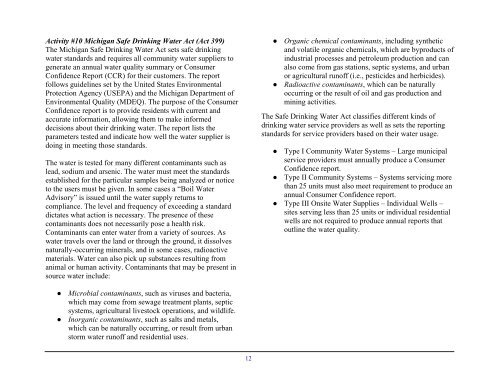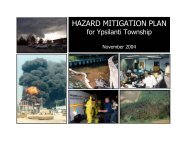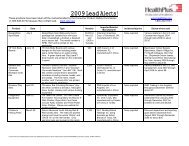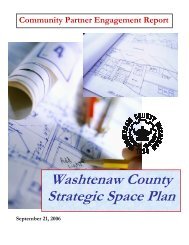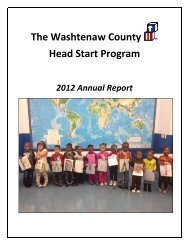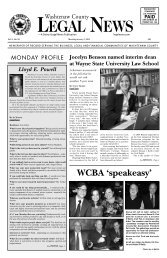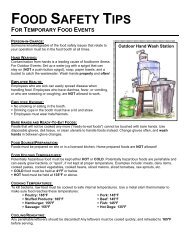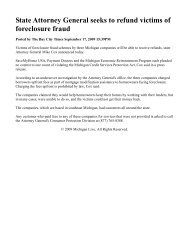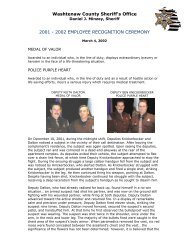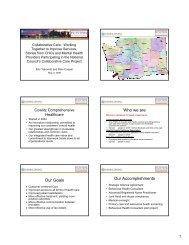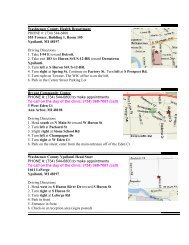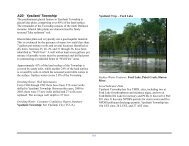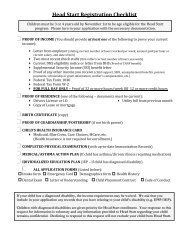Water Protection Activities in Washtenaw County
Water Protection Activities in Washtenaw County
Water Protection Activities in Washtenaw County
You also want an ePaper? Increase the reach of your titles
YUMPU automatically turns print PDFs into web optimized ePapers that Google loves.
Activity #10 Michigan Safe Dr<strong>in</strong>k<strong>in</strong>g <strong>Water</strong> Act (Act 399)<br />
The Michigan Safe Dr<strong>in</strong>k<strong>in</strong>g <strong>Water</strong> Act sets safe dr<strong>in</strong>k<strong>in</strong>g<br />
water standards and requires all community water suppliers to<br />
generate an annual water quality summary or Consumer<br />
Confidence Report (CCR) for their customers. The report<br />
follows guidel<strong>in</strong>es set by the United States Environmental<br />
<strong>Protection</strong> Agency (USEPA) and the Michigan Department of<br />
Environmental Quality (MDEQ). The purpose of the Consumer<br />
Confidence report is to provide residents with current and<br />
accurate <strong>in</strong>formation, allow<strong>in</strong>g them to make <strong>in</strong>formed<br />
decisions about their dr<strong>in</strong>k<strong>in</strong>g water. The report lists the<br />
parameters tested and <strong>in</strong>dicate how well the water supplier is<br />
do<strong>in</strong>g <strong>in</strong> meet<strong>in</strong>g those standards.<br />
The water is tested for many different contam<strong>in</strong>ants such as<br />
lead, sodium and arsenic. The water must meet the standards<br />
established for the particular samples be<strong>in</strong>g analyzed or notice<br />
to the users must be given. In some cases a “Boil <strong>Water</strong><br />
Advisory” is issued until the water supply returns to<br />
compliance. The level and frequency of exceed<strong>in</strong>g a standard<br />
dictates what action is necessary. The presence of these<br />
contam<strong>in</strong>ants does not necessarily pose a health risk.<br />
Contam<strong>in</strong>ants can enter water from a variety of sources. As<br />
water travels over the land or through the ground, it dissolves<br />
naturally-occurr<strong>in</strong>g m<strong>in</strong>erals, and <strong>in</strong> some cases, radioactive<br />
materials. <strong>Water</strong> can also pick up substances result<strong>in</strong>g from<br />
animal or human activity. Contam<strong>in</strong>ants that may be present <strong>in</strong><br />
source water <strong>in</strong>clude:<br />
● Microbial contam<strong>in</strong>ants, such as viruses and bacteria,<br />
which may come from sewage treatment plants, septic<br />
systems, agricultural livestock operations, and wildlife.<br />
● Inorganic contam<strong>in</strong>ants, such as salts and metals,<br />
which can be naturally occurr<strong>in</strong>g, or result from urban<br />
storm water runoff and residential uses.<br />
12<br />
● Organic chemical contam<strong>in</strong>ants, <strong>in</strong>clud<strong>in</strong>g synthetic<br />
and volatile organic chemicals, which are byproducts of<br />
<strong>in</strong>dustrial processes and petroleum production and can<br />
also come from gas stations, septic systems, and urban<br />
or agricultural runoff (i.e., pesticides and herbicides).<br />
● Radioactive contam<strong>in</strong>ants, which can be naturally<br />
occurr<strong>in</strong>g or the result of oil and gas production and<br />
m<strong>in</strong><strong>in</strong>g activities.<br />
The Safe Dr<strong>in</strong>k<strong>in</strong>g <strong>Water</strong> Act classifies different k<strong>in</strong>ds of<br />
dr<strong>in</strong>k<strong>in</strong>g water service providers as well as sets the report<strong>in</strong>g<br />
standards for service providers based on their water usage.<br />
● Type I Community <strong>Water</strong> Systems – Large municipal<br />
service providers must annually produce a Consumer<br />
Confidence report.<br />
● Type II Community Systems – Systems servic<strong>in</strong>g more<br />
than 25 units must also meet requirement to produce an<br />
annual Consumer Confidence report.<br />
● Type III Onsite <strong>Water</strong> Supplies – Individual Wells –<br />
sites serv<strong>in</strong>g less than 25 units or <strong>in</strong>dividual residential<br />
wells are not required to produce annual reports that<br />
outl<strong>in</strong>e the water quality.


